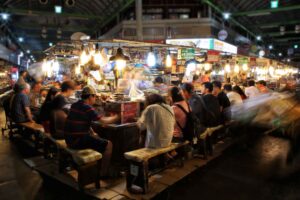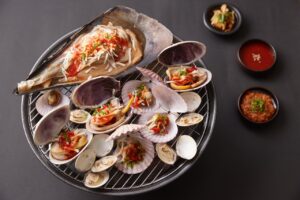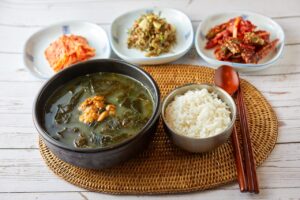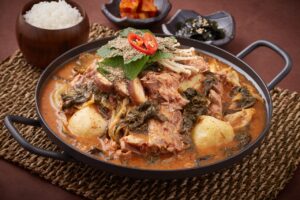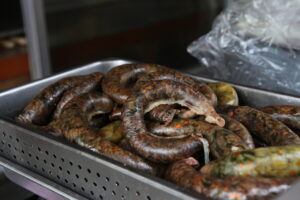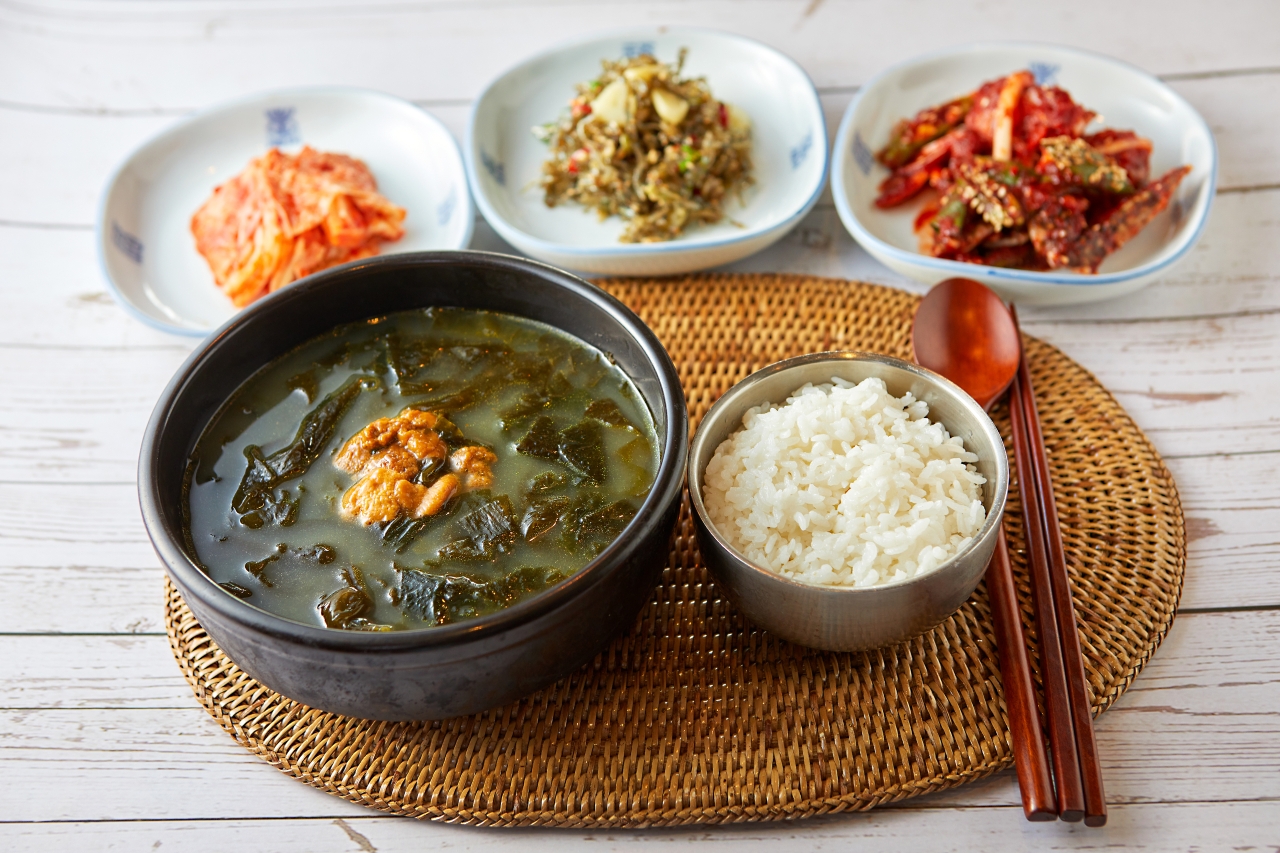
Miyeokguk- ⓒ한국관광공사 사진갤러리 - 살롱드베이커
Miyeokguk, Birthday Soup.
Miyeokguk is a traditional Korean seaweed soup made with miyeok, which is a type of sea vegetable commonly known as wakame in Japanese. This soup is often associated with birthdays in Korea and is considered a comfort food. It is believed that miyeokguk is a nutritious and replenishing dish, making it a popular choice for celebrating birthdays.
The main ingredients in miyeokguk typically include miyeok (seaweed), beef or sometimes seafood, garlic, soy sauce, and sesame oil. The seaweed is first soaked and then cooked with other ingredients to create a flavorful broth. It is often garnished with thinly sliced green onions.
In Korean culture, miyeokguk is commonly consumed by new mothers during the postpartum period as it is believed to have health benefits and is thought to help with recovery. The dish is also enjoyed on birthdays as a way to symbolize growth, renewal, and the cycle of life.
It’s important to note that variations of miyeokguk exist, and the specific ingredients and preparation may vary from one region or family to another.
History
In Korean culture, the tradition of eating miyeokguk on one’s birthday is rooted in the belief that consuming this seaweed soup symbolizes the cycle of life, growth, and renewal. Miyeok, the main ingredient in miyeokguk, is rich in nutrients, including iodine, calcium, and vitamins, making it a healthy and nourishing dish.
Here are a few key aspects of the tradition:
Symbolism of Growth and Renewal: The long, slender strands of miyeok are seen as representing longevity and growth. By eating miyeokguk on their birthday, Koreans express a wish for a healthy and prosperous year ahead and symbolize the idea of growing another year older.
Remembrance of Mother’s Sacrifice: There’s also a connection between miyeokguk and the postpartum period. Traditionally, new mothers are often served miyeokguk after giving birth as it is believed to aid in recovery and provide essential nutrients. By consuming miyeokguk on one’s birthday, individuals may be acknowledging and remembering the sacrifice and care their mothers provided during their early years.
Cultural Significance: Miyeokguk has become deeply ingrained in Korean birthday celebrations, and it is considered a comforting and familiar dish. Families often come together to share a meal of miyeokguk on birthdays, reinforcing the cultural significance of the tradition.
While the tradition may vary among individuals and families, the overall theme is one of celebrating life, expressing gratitude, and wishing for a healthy and prosperous future. It’s a cultural practice that reflects the importance of food not only as sustenance but also as a symbol of cultural values and beliefs.

Cooking Method
Making Miyeokguk involves a few key steps, and the recipe may vary slightly based on personal preferences and regional variations. Here’s a basic recipe for Miyeokguk: Ingredients:
1 cup dried miyeok (wakame seaweed) 1/2 pound beef (flank or brisket), thinly sliced 8 cups water
2 tablespoons soy sauce
1 tablespoon sesame oil
3 cloves garlic, minced
Salt to taste
Sliced green onions for garnish
Instructions:
Prepare the Miyeok (Seaweed):
Soak the dried miyeok in cold water for about 30 minutes or until it expands and becomes soft.
Rinse the soaked miyeok in cold water and cut it into bite-sized pieces.
Prepare the Beef:
Slice the beef thinly, and if you’re using brisket, it’s a good idea to parboil it for about 5 minutes to remove any impurities.
Cooking:
In a large pot, bring 8 cups of water to a boil.
Add the sliced beef to the boiling water and cook until the meat is fully cooked and tender.
Add Miyeok and Flavorings:
Once the beef is cooked, add the soaked and cut miyeok to the pot.
Add minced garlic, soy sauce, and sesame oil to the pot.
Let the soup simmer for an additional 10-15 minutes until the miyeok is tender.
Season and Serve:
Season the soup with salt to taste.
Garnish with sliced green onions before serving.
Serve Warm:
Miyeokguk is traditionally served warm and is often accompanied by a bowl of rice.
Remember that the proportions and specific ingredients can be adjusted to suit your taste. Some variations may include adding other vegetables or using different cuts of meat. The important thing is to capture the essence of the dish and its symbolic meaning in Korean culture.
Regional Characteristics
While Miyeokguk is a dish that’s enjoyed throughout Korea, there can be regional variations in the way it’s prepared. Different regions may have distinct ingredients, preparation methods, or additional elements that reflect local tastes and preferences. Here are a few potential regional characteristics of Miyeokguk in Korea: Jeju Island:
Given its coastal location, Miyeokguk in Jeju may incorporate local seafood, such as small octopus or abalone, in addition to beef. The emphasis on fresh, local ingredients is a characteristic of Jeju cuisine.
Gyeonggi Province:
In regions like Gyeonggi, which surrounds Seoul, you might find a more urban influence on the dish. People may choose to include a variety of additional vegetables or use a combination of beef and pork for a richer flavor.
Gyeongsang Province:
Gyeongsang cuisine is known for its bold and spicy flavors. Miyeokguk in this region might include additional spicy elements like red pepper flakes or gochujang (red chili paste) to add heat to the broth.
Gangwon Province:
In colder regions like Gangwon, people may prefer heartier versions of Miyeokguk with more substantial ingredients to combat the cold weather. This could include additional root vegetables or mushrooms.
Southern Regions:
In southern regions like Jeolla, where agriculture is prominent, Miyeokguk may incorporate a variety of seasonal vegetables. The soup may have a fresher and lighter taste compared to heartier versions found in colder regions.
It’s important to note that these are general observations, and individual preferences within regions can still vary widely. Miyeokguk is a dish that has cultural and personal significance, and the way it’s prepared can be influenced by factors such as family traditions, personal taste, and the availability of local ingredients. If you’re interested in exploring regional variations, it might be worthwhile to try Miyeokguk in different areas of Korea or learn from individuals who have specific regional culinary traditions.
…
…
…
Recommend to Read >>> JogaeGui, The Most Famous Shellfish Dishes Nov. 2023
